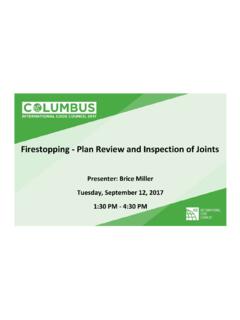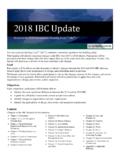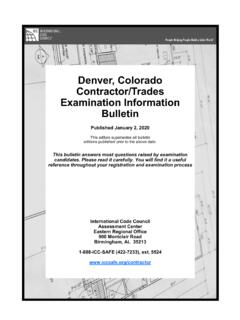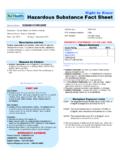Transcription of Session: Venting. Reinvented, UL 1738 Fuel Gas Venting …
1 Session: Venting . Reinvented, UL 1738 Fuel Gas Venting SystemsUL 1738 Flue Gas Venting SystemsGaetano AltomareProduct Manager - PlumbingVenting. is Flue Gas?2. Venting History3. Model Codes and Standards4. UL 17385. System 17386. Design Considerations7. Installation RequirementsIPEX | Certified Flue Gas Venting Solutions37/26/2019 What is Flue Gas? Flue Gas is a by-product of incomplete combustion often coming from sources such as a fireplace, oven, furnace, boiler, water heater or steam + 5O2 2CO + 8H2O+ 2C + HeatNatural Gas + Oxygen Carbon Monoxide + Water Vapor + Carbon (Soot) It consists mainly of carbon monoxide and water vapor and is required to be vented safely to avoid | Certified Flue Gas Venting Solutions47/26/2019 What is Flue Gas?Gas-Fired Appliances are divided into 4 Venting categories:1. Category I Negative Pressure, Non-Condensing2. Category II Negative Pressure, Condensing3.
2 Category III Positive Pressure, Non-Condensing4. Category IV Positive Pressure, CondensingToday, we will be speaking about Venting Category II and IV AppliancesAgenda1. What is Flue Gas? History3. Model Codes and Standards4. UL 17385. System 17386. Design Considerations7. Installation RequirementsIPEX | Certified Flue Gas Venting Solutions67/26/2019 Venting History Conflicting Standards? Appliance Manufacturer s currently dictate which materials are approved for Venting with their appliance in conjunction with the local codes. Since no practical Venting standards existed, appliance manufacturer s referenced ASTM plumbing standards in their installation manuals. Example: Venting History Conflicting Standards? Conversely, manufacturer s of the plumbing pipe and fittings do not endorse, promote or warranty their products for flue gas Venting applications. The Reason: Products manufactured to ASTM Standards are manufactured for fluid handling applications and are not designed or tested for flue gas Venting applications CSA and ASTM standards are written for fluid handling plumbing applications CSA and ASTM plumbing standards offer a wide spectrum for dimensional tolerances Manufacturers adhere to different manufacturing practices and tolerances Insufficient installation resources and training for flue gas Venting applications Installers take for granted the skill required to install a thermoplastic vent system Carbon Monoxide is a silent killer Uniform industry regulations for Venting does not exist Industry ConcernsCO Statistics In 2014, the Consumer Product Protection Association reported 165 unintentional non-fire CO poisoning deaths; an increase of 11% from the average number of reported incidents between 2012 2013.
3 Of these reported incidents, heating system fatalities represented the largest percentage at 39% or 65 deaths. Some examples of vent failures that exhibit either embrittlement, material degradation or vent separation were reported and documented in Aspen Colorado, Nashua New Hampshire, South Bend Indiana, and Port Mouth VirginiaAgenda1. What is Flue Gas?2. Venting Codes and Standards4. UL 17385. System 17386. Design Considerations7. Installation RequirementsIPEX | Certified Flue Gas Venting Solutions117/26/2019 Model Codes and Standards The following ASTM Plumbing Standards are commonly referenced in appliance manufacture s installation manuals: ASTM D2665 PVC Plastic Drain, Waste and Vent Pipe and Fittings ASTM D1785 PVC Plastic Pipe, Schedules 40, 80 and 120 ASTM D2241 PVC Pressure-Rated SDR Pipe ASTM D2846 CPVC Plastic Hot and Cold Water Distribution Systems ASTM F441 CPVC Plastic Pipe Schedule 40 and 80 ASTM F442 CPVC Plastic Pipe SDR ASTM D2661 ABS Schedule 40 Plastic Drain, Waste and Vent Pipe and FittingsThese standards are all intended for fluid handling applicationsModel Codes and Standards As a result of plumbing products being used for flue gas Venting applications and appliance manufacturer s referencing these standards, the following note has been added to the ASTM D1785 standard scope: NOTE.
4 This standard specifies dimensional, performance and test requirements for plumbing and fluid handling applications only. It does not include provisions for the use of these products for Venting of combustion gases. UL 1738 is a standard that does include specific testing and marking requirements for flue gas Venting products, including PVC. This note or something similar has been added to each of the ASTM plumbing standards previously Code and Standards - Update2018 National Fire Protection Association (NFPA) Code 54 National Fuel Gas Code NFPA 54 Chapter 12, Section 5: Venting Appliances, Type of Venting Systems to Be Used, Plastic plastic piping is used to vent an appliance, the appliance shall be listed for use with such Venting materials and the appliance manufacturer s installation instructions shall identify the specific plastic piping material. The plastic pipe Venting materials shall be labeled in accordance with the product standards specified by the appliance manufacturer or shall be listed and labeled in accordance with ANSI/UL 1738: Venting Systems for Gas-Burning Appliances, Categories II, III, and Plastic Vent pipe and fittings used to vent appliances shall be installed in accordance with the appliance manufacturer s installation instructions.
5 Plastic pipe Venting materials listed and labeled in accordance with ANSI/UL 1738, Venting Systems for Gas-Burning Appliances, Categories II, III, and IV,shall be installed in accordance with the vent manufacturer s installation instructions. Where primer is required it shall be of contrasting Code and Standards - Update2018 International Fuel Gas Code (IFGC) IFGC Chapter 5, Section 3: - Chimneys and Vents, Venting of Plastic plastic piping is used to vent an appliance, the appliance shall be listed for use with such Venting materials and the appliance manufacturer s installation instructions shall identify the specific plastic piping material. The plastic pipe Venting materials shall be labeled in accordance with the product standards specified by the appliance manufacturer or shall be listed and labeled in accordance with ANSI/UL Plastic Vent pipe and fittings used to vent appliances shall be installed in accordance with the appliancemanufacturer s pipe Venting materials listedand labeled in accordance with UL 1738 shall be installed in accordance with the vent manufacturer s installation instructions.
6 Where primer is required it shall be of contrasting Code and Standards - UpdateWhat Does this Mean?I. Appliance manufacture s will still dictate suitable materials for Venting their appliancesII. Installers now have a choice:1. Use products listed to ASTM plumbing standards2. Use products certified to UL 1738 The ASTM plumbing standards state they are not suitable for Venting poisonous flue , utilizing materials listed to UL 1738 is something designers, manufacturer s and installers should be consideringand recommendinguntil it becomes Standards ANSI Z21 Paradox of Rules?7/26/2019 IPEX | Certified Flue Gas Venting Solutions18 NFPA 54 OEMsASTM StandardsIFGCIMCUL 1738 Model Codes and Standards There is a clear disconnect between appliance manufacture s, vent manufacturer s and model codes and standards. The Solution is simple UL 1738. UL 1738 allows for: The appliance manufacturer s to continue dictating their preferred Venting material.
7 Certified Venting materials to replace plumbing products which are not intended for the application or warrantied by their manufacturer s. A uniform standard that eliminates the disorganization and confusion that comes with each jurisdiction using their adopted codes and standardsMake it LawAgenda1. What is Flue Gas?2. Venting History3. Model Codes and 17385. System 17386. Design Considerations7. Installation RequirementsIPEX | Certified Flue Gas Venting Solutions217/26/2019UL 1738 UL 1738 is a standard for Venting Systems for Gas-Burning Appliances, Categories II, III, and IV. It covers both metallic and non-metallic materials and includes over 50 material and system performance tests. Using products listed to UL 1738 provides the highest possible chance of success for flue gas Venting 1738 Key Test RequirementsUL 1738 Additional requirements Products certified to UL 1738 require listed print lines on pipe and labels on fittings that allow for identification regardless of orientation.
8 Manufacturer s of UL 1738 products are required to provide installation instructions for their products. UL 1738 states NO mixing of components from different manufacturer s in a single vent system. Using UL 1738 certified products provides the greatest possible chance of success in flue gas Venting applicationsCodes and Standards Precedent Adopting a Venting standard is not without In 2007, CSA was mandated in Canada and required that all vent material/systems be certified to ULC S636. This included PVC, CPVC, PP and SS. This covered all new and retrofit installations and required all installations use one brand for pipe, fittings, cements and transitions. Appliance manufacturer s still dictate which vent material is approved to vent their What is Flue Gas?2. Venting History3. Model Codes and Standards4. UL 17386. Design Considerations7. Installation RequirementsIPEX | Certified Flue Gas Venting Solutions267/26/2019 System 1738 The First Engineered PVC Flue Gas Venting System certified to UL 1738 Permanent Solvent Welded Joints Sizes include 2 , 3 and 4 OD Dimensions in accordance with ASTM D1785 Pipe, fittings, terminations and cements from a single manufacturerSystem 1738 PipePipe is Black with 2 Orangeprint lines 180 apart Line A: System 1738 Gas Vent Categories II, IV 149 F / 65 C PVC UL 1738 Min.
9 Clearance to combustible construction 0mm manufacture's installation instruction must be followed / <Date Code>Made in USA by IPEX USA LLC Line B: System 1738 Gas Vent Categories II, IV 149 F / 65 C System 1738 Gas Vent Categories II, IV 149 F / 65 CSystem 1738 FittingsFittings are Black with 2 Orangelabels 180 apart on the fitting hub Label A:System 1738 Label B:Carbon Monoxide Warning (only used with tee-wye fitting)System 1738 Primer & CementIPEX System 1738 Labelled Primer & Cement Primer is fluorescent yellow to provide contrasting color per UL 1738 Cement is auburn to match the pipe print line color Low VOC Optical Brightener for Compliance Verification Pint and Quart SizesSystem 1738 Concentric Terminations Sizes include 2 , 3 and 4 Single termination hole Various lengths up to 44 Solvent Weld or Mechanically Fastened Cap Can be painted to match building exterior Bird Screen, Face Plate & Roof Flashing Accessories available Must be approved by the appliance manufacturerSystem 1738 Low Profile Terminations Sizes include 2.
10 3 and 4 Two hole termination Can be painted to match building exterior Must be approved by the appliance manufacturerSystem 1738 Specialty FittingsAccess Tee Drilling of System 1738 is prohibited Drilling compromises system integrity and can result is stress cracking Caulking or metal tape are not permanent solutions The System 1738 Access Tee provides a safe method for testing appliance combustion 1738 - Accessories Pipe Cutter Deburring ToolSystem 1738 Design & InstallationVent Sizing What material should be used to vent? What should the vent size be? What is the maximum vent length allowed with the appliance? What is the equivalent vent length of each fitting? Consult the appliance manufacturer s installation instructionsSystem 1738 Design & InstallationIPEX offers a comprehensive Installation Guide that outlines best practices covering: Terminations Side Wall, Pitched and Flat Roof Chimney Installations Support and Restraint Spacing Expansion and Contraction Firestops Appliance Vent ConnectionsWhile you must always follow local codes, IPEX offers support when you need 1738 TrainingIn addition to the comprehensive Installation Guide, IPEX offers training to engineers, inspectors, distributorsand contractors.










